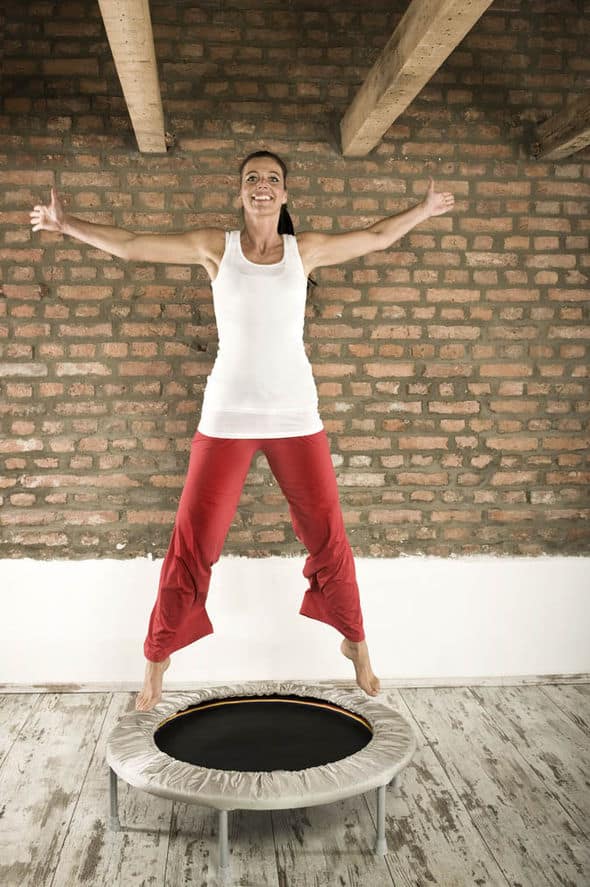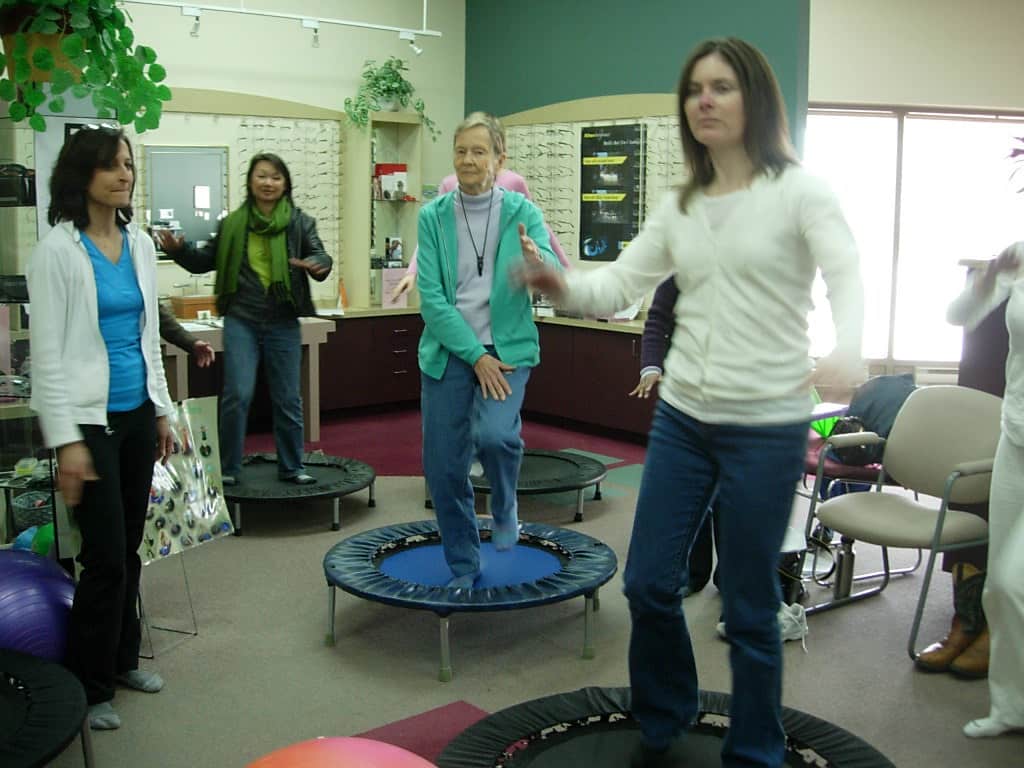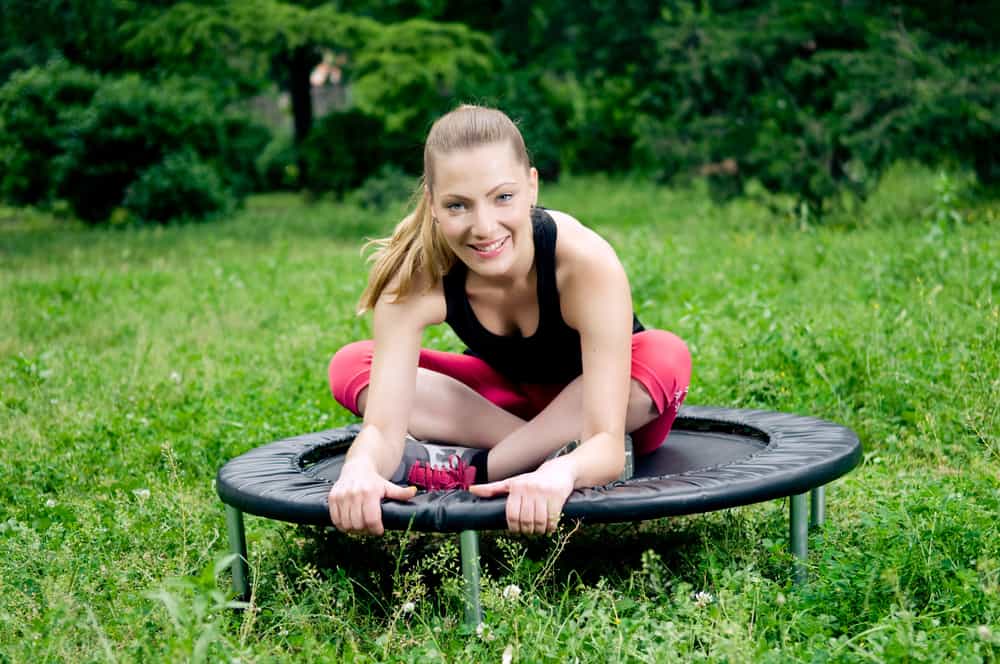How Does Rebounding Improve Eyesight?
Rebounding is an exercise that provides a number of benefits, such as reducing body fat, toning muscles and improving balance. The most appealing aspect of rebounding is you can perform it anywhere.
It’s easy to set up and suitable for all levels of fitness. But how does bouncing on a rebounder improve your eyesight? Rebounding improves eyesight because while jumping up and down your eyes adjust continually to different fields of vision. This strengthens the eye muscles by stimulating the vision receptors which are responsible for tracking objects. Therefore rebounding is used to bring efficient visually guided movement of the entire body and gives enhanced awareness.
If you are looking to buy the best rebounders, check out our comparison article to make your decision easier!
Ready to start your rebounder weight loss journey? Try out our 8-week rebounder program!

Let’s look in more detail at how rebounding improves vision and eyesight.

A vision therapist in Washington discovered that rebounding exercise techniques are valuable for the eye muscles, specifically for correcting contracting of the cornea. This is because the movement creates a primary guiding system for movement through vision.
While jumping up and down we concentrate on certain areas as visually guided body movements. Therefore rebounding is used to bring efficient visually guided movement of the entire body and gives enhanced awareness.
Rebounding also enhances directional awareness between left and right which makes it favourable among optometrists when prescribing vision therapy to patients.
Dr Shankman who works with patients in optometric vision training, incorporates rebounding exercising as part of his visual training protocol. He uses this because he wants his patients to be able to identify a stimulus while the body experiences a changing stimulus through constant directional change.
Using a rebounder permits total body awareness of where you are by helping you gather clues of your surroundings. This helps you interpret information faster and see more effectively.
Additionally, rebounding forces you to learn coordination. If you do not keep balance on the rebounder you risk injury by falling off the equipment.
This improves eyesight by relating the objects around you to the space you are occupying during the movement.

Visual therapist Raymond Gottlieb adds that rebounding aerobics improves eyesight through rhythm correction. People who suffer from ineffective vision are due to lack of rhythm.
Jumping up and down on a rebounder provides rhythm to the brain through systematic bouncing. Your bounce acts like a metronome and rebounding allows your eyes to generate a rhythm.
The section of the brain that receives the sensory input is called the thalmus, particularly visual and auditory information. The thalmus organises these readings during the rebounding movement and while this happens it generates enhanced lymphatic circulation which provides more energy for vision.
Visual therapists working with a rebounder assists the patient monitor their own errors and use a systematic approach to visual improvements. Dr Shankman uses visual exercises such as mounting a newspaper page to the wall, the patient bounces on the rebounder while they read different sized headlines on the page.
Using this particular exercise is a good way to strengthen vision while you use a rebounder. This is because the anatomy of the eyes are comprised of body cells, every cell in the body is similar.
The bouncing movement on a rebounder has an impact on the eye cell where gravity develops a greater impact at the bottom of the bounce. During exercise every cell is being stimulated, physical cellular strength builds the eye cells at the deceleration phase on the rebounder.
Rebounding and stress
One primary reason for people to wear glasses is due to stress. Exercising on a rebounder can eliminate stress. In stressful situations the body closes down and you follow a characteristic pattern of dealing with stress.
Using a rebounder exposes this stress pattern to you and you receive a positive reward created by the bouncing movement. This reinforcement allows you to learn your stress pattern and break through the stress.

Irrespective of your eye condition they can be improved beyond the vision you currently have, unless you are sightless of course. The result of applying visual therapy through using a rebounder is improved perception.
The eyes are a semi-muscular organ that must be exercised like any other muscle. In visual therapy the techniques used are specific eye muscle movements to improve the conditioning of the eyes.
As rebounding exercises every muscle in the body the eyes are included in this.
Rebounding exercises for Improved Vision
Lack of exercise and living a sedentary lifestyle can be a contributing factor for deteriorating vision. The good news is that there are ways to improve eyesight, one of them is through exercises like rebounding!
As mentioned, rebounding stimulates the eye cells along with every other cell in the body, due to the increased effect of resistance to gravity.
By doing eye exercises while on a rebounder you can help stimulate the cells within the lenses which increase their ability to meet varying visual requirements.
For example, placing your rebounder next to a window, you can focus on one particular object that is relatively far away. Then focus on on object that is near to you – preferably in the same room.
While you rebound, change the focus back and forth between the object that you are focussing on far away and the near object. This shift in focus is what corrective lenses do and you can repeat this daily until improvements are identified.
If you do this regularly it’s not unusual to expect significant natural vision correction within a matter of weeks.

Can Rebounding Improve Vision?
No matter your age, your eyesight can be improved by bouncing on a rebounder regularly. If you don’t have eye problems it’s highly recommended to start rebounding for prevention of deteriorating vision, especially as we age.
Not only is rebounding fun but it’s a simple and easy way to do so.
Most rebounders are small in structure and fold up easily for storage. Many medical professionals and visual therapists are recommending rebounding for their patients.
Not only for eyesight but also all the other benefits they offer. It’s important to invest in a high quality rebounder that is durable but lightweight.
The most important thing to consider is staying consistent with it, rebound for 20 minutes a day and include the focussed vision task. Doing this regularly will not only improve your eyesight but also prevent losing it.
An ex-triathlete, fitness coach and writer with a Masters in Sports Physiology. Fitness is my passion and I've had my fair share of home fitness equipment tried and tested!


